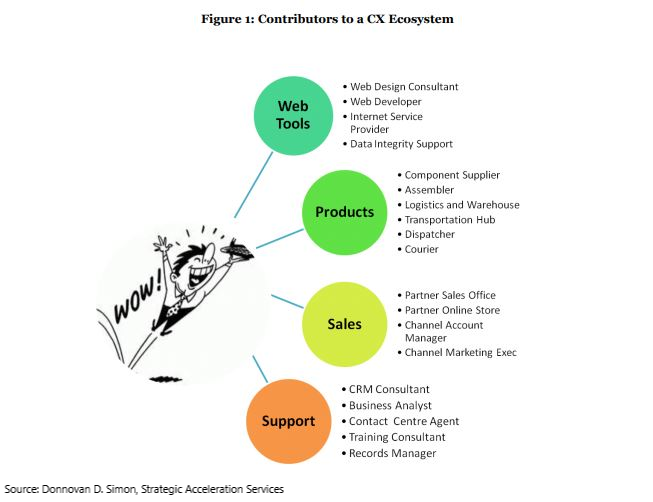
Focusing on the linear customer journey is no longer enough in an age where companies now compete primarily on customer experience. Experiences are comprised of many relationships and processes, so it’s crucial to look at the entire connected landscape, or ecosystem.
Coined by Forrester, a customer experience ecosystem is defined as the web of relations among all aspects of a company―including its customers, associates, partners, and operating environment―that determine the quality of the customer experience. Below, we’ve outlined how to map your ecosystem to improve your customer experience.
Elements of a Customer Experience Ecosystem
As is true of any ecosystem, everyone must work together to achieve success. Even though your customer may never interact with your suppliers or know who your email marketing provider is, these relationships may still impact their overall experience. The first step in mapping your ecosystem is to define the different elements that contribute to your customer experience.

Customers
Your customers should be at the center of your ecosystem. Rather than forcing your customers to adapt to your ecosystem, the expectations of your customers should influence the way your entire ecosystem operates. With virtually unlimited options to consumers, customers won’t hesitate to find another company that’s more willing to listen to and shape their customer experience around their needs.
Leverage data from website analytics, purchase history, social media, voice of the customer tools, and market research to identify your customers and understand their expectations. This data will impact the goals and expectations of all the other elements in your ecosystem.
Associates
While customers define the expectations, your associates are the ones who influence their experiences. When mapping your ecosystem, consider all departments, even the non-customer-facing positions. Every department has a pivotal role in shaping your overall customer experience.
At SunTrust, for example, associates started asking in meetings, “Do we believe X because we’ve been bankers for Y years, or because clients told us?” As a result, a new commonplace practice was formed as a suitable way to challenge the company’s thinking—always double-check internal assumptions.
Listen to what your customers are saying and promote a workplace culture of open communication to ensure your customers’ expectations are heard. Furthermore, ensure that every one of your associates not only understands your mission and values, but also how each department influences your customer experience. This will help triage issues and provide faster resolution times to customer queries and complaints.
Partners
It’s often easy to forget about your company partners when you may not interact with them every day or see them around the office. However, partners like a supplier, delivery service, and even your mystery shopping partner often extend your ecosystem beyond customer touchpoints.
With studies showing the demand for ethically and sustainably sourced products, Starbucks’ Supplier Social Responsibility Standards serves as a great example of how a supply chain can impact customer experience. Whether it be coffee beans, cups, aprons, or lighting fixtures, the coffee retailer ensures its supplier network supports its mission of sustainability and humanity through ethical sourcing.
Build close relationships with your partners by bridging the gap between partner data and experiences and your own. Furthermore, communicate your values to ensure they align with your partners’. This can help prevent poor communication and negative impressions from influencing your ecosystem.
Operating Environment
Software, such as your CRM platform, web hosting provider, or quality assurance software with which your customers, associates, and partners interact can impact your customer experience ecosystem. This influences not only how seamlessly your customer experience runs, but also how well these different operations work with one another.
For example, mobile is the preferred platform for opening and reading email, so it’s important that your emails are responsive to different screen sizes. If the email marketing platform you use isn’t responsive, you may end up with a mishap like Macy’s, where the buttons were too small and crowded for users to click on them.
Ensure the different platforms, tools, and programs used in your business operations are compatible with one another. Incompatible technology can result in inaccessible data and friction along the customer journey.
Customer Experience Ecosystem Map

After identifying the many elements that make up your ecosystem, you’ll need to identify where each element falls in your customer journey, and how the different elements are connected to one other.
Start at the beginning, which, for many businesses, will be the manufacturing of the product. If you sell hamburgers, for example, what are all the elements that contribute to those hamburgers? Where do you buy your meat? Who delivers it? Who unloads and signs for the delivery?
From there, you can move along the customer journey. How does a customer discover that your business sells hamburgers? Does the customer go to your website? See it on social media?
Continue this process until the customer has not only completed the purchase, but used (or in this case, eaten) the product and shared their experience with other consumers.
Improve Your Customer Experience
According to Forrester, companies that utilize ecosystem mapping can expect multiple benefits, including detailed knowledge of the customer journey, a greater understanding of interdependencies, and better communication across functional silos. In fact, organizations that take an interconnected approach to customer experience are 20 percent more likely to significantly exceed their top business goals.
Need a partner in your ecosystem that can help improve customer experience at your organization? Whether it’s conducting market research, collecting customer data, or verifying your expectations, IntelliShop has the solutions to ensure a seamless customer experience from start to finish. Contact IntelliShop today to request a consultation.
Related Articles
How Kindness Can Create a Better Overall Customer Experience
A recent Wall Street Journal article reminds us of the role that kindness plays within customer experience, both on the staff and end consumer sides. This is especially important in the current Covid-19 environment for the restaurant and hospitality industries as several...
Why Emotion Matters in the CX Journey
Establishing an emotional connection with your customers is important to establish loyalty, drive more revenue and increase customer lifetime value for your business. How you capture emotion can vary from post-transaction surveys, to requesting reviews of their experience to...
Top Tags
Solutions
Recent Articles
Contact Us
Schedule a ConsultationTalk Shop
View All ArticlesSafe Experience
IntelliShop’s COVID-19 Compliance Check and Greeter Services are instrumental in the successful execution of our health and safety requirements. Our high IntelliShop Audit scores provide us the confidence in our stores ability to pass any external audits conducted by local health, safety, labor, or other agencies, while at the same time creating an environment that promotes a safe shopping experience for our customers.


